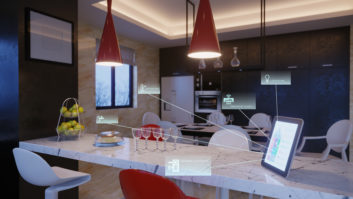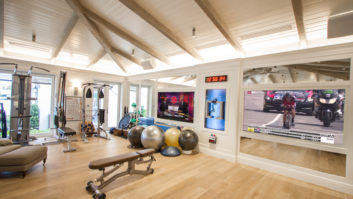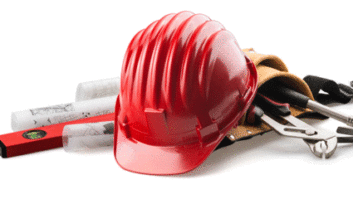Nobody gets into the home integration business hoping to just hang a few TVs. In this industry, it’s all about going big; the dream of equipping a palatial estate with enough tech tools to make James Bond jealous. To work at the intersection of luxury and cutting-edge technology on the largest possible scale is the El Dorado for which nearly every integrator strives.
But these mega projects are more than just ramped-up installs. With work schedules extending more than three years, these jobs require as much management skill as technical expertise to end up with a successful result, and a happy client.
Mega management is something Ryan Heringer, owner and president of Jonesboro, AR-based Sound Concepts, knows intimately well. Operating one of the largest integration firms in the Southeast U.S., Heringer has managed the integration of some jaw-dropping residences, like a recently completed 43,000-square-foot home in Hardy, AR.

This home in Hardy, AR, took more than four years to build and features a 14-car garage, four-story indoor climbing wall, industrial-scale indoor deer processing plant, and a big sports court, and huge pool.
Featured on television programs such as Discovery Channel’s “Clash of the Ozarks” miniseries and Sportsman Channel’s Amazing America with Sarah Palin, the home features the world’s largest ELAN g! automation system, and a ton of things to control. Highlights of the home include a 14-car garage, four-story indoor climbing wall, industrial-scale indoor deer processing plant, a big sports court, and huge pool. “The pool is probably one of the coolest pools I’ve ever done,” Heringer said. “They actually built a Playboy-mansion-style grotto that you swim underneath and go up into. And it holds 25 to 30 people.” And of course, everything is wired and equipped with touchpanels to control everything from lighting, to music, to video.
According to Heringer, who has done more than seven projects of this size, the design phase was a three-month process. Initially, his designs specified a Crestron system; however, he changed it to ELAN to provide a more competitive estimate and edge out the contending firm.

This 43,000-square-foot home features the largest ELAN g! system in the world, with every room fully automated.
“They were bidding Crestron, and their margins are different that what residential guys’ are typically,” he recalled. “They work on typically smaller margins than residential guys do, just because they don’t understand the change orders and everything that goes on in residential, whereas in commercial its on the plans, here’s what you do.”
And, as it turned out, the construction of the home did present some challenges that someone on the commercial side might not have expected. The home took more than four years to complete, owing to its antediluvian, hand-hewn construction techniques. “They hand made all the beams that go in it, and didn’t use screws,” Heringer said. “It was like pegs, like a Lincoln Log set. And as they put it together, they used the left and right wings and then built it toward the center of the house. So with us, wiring the house, everything’s central to a rack. So we could start on certain projects, but not really run any wires, as far as prep work, because the house had to actually be connected.”
In the end, the list of connected items is staggering: nearly 30 flat panel TVs, 26 video zones, 30 audio zones, more than 300 lighting loads, 24 surveillance cameras, and 12 HVAC zones.
“You can’t complete a job like this without adding extra labor to your budget, because you’re going to need it,” Heringer said. “For something that’s going to be drawn out over a three- or four-year period, you need to make sure you have plenty of labor estimated.”
Another integrator with a wealth of experience on the large-scale end of the install business is Joe Stay, designer at Hoishik, an integration firm based out of Spring City, PA, a suburb of Philadelphia. With more than 15 years of work on big projects, he’s seen a number of other integrators stumble while going for the gusto.

This 15,000-square-foot Colorado ski retreat features full Crestron automation, with control of additional amenities such as the heated driveway, sidewalks, and snow melting system.
“One of the challenges that I see that a lot of integrators face, is when you first take on a big project, I think they under-estimate the amount of time that has to go into a project like that,” Stay said. “I think a lot of guys will get large projects, and especially when they haven’t done them, they see a big dollar amount on the project in the beginning, but really have no idea how to bid the process as far as the amount of time and labor and everything that goes into it, and in the end they find out that they’re not experienced enough to be able to program something like that.” He and his team have programmed some very interesting installations, including one that earned an award from Crestron. In a 7,000-square-foot home in Chester County, PA he installed a fully integrated Crestron lighting and AV distribution system, with a curious twist. The basement of the home features a guest room modeled to resemble a cave, with quartz crystals throughout. The Hoishik team came up with an idea of building on the theme and installed RGB LED lights behind the crystals. They then rigged the control system so that when a user inserts a specific eight-inch quartz crystal into one of five hidden ports in the room, a particular theme is initiated. A lava them illuminates all of the crystals red, and a subwoofer rumbles like an earthquake; a moonlight theme lights all of the crystals blue and insect sound effects play.
Other large projects undertaken recently by Stay and his team include a 12,000-square-foot home with a Crestron-based automation system that’s simple enough for its 93-year-old resident to master, and a home replete with a bowling alley with lighting effects, a pool house media room, and 24-zone sound system.
Beyond an acute awareness of one’s own capabilities, Stay advises to be wary of the difficulty of coordinating with the multitude of other trades involved in projects of this scale. “When you’re an integrator, you’ve got to count the time to integrate with the electrician, the HVAC guys, the plumbers, the pool guys, the sprinkler guy, the spa guy, the gate guy,” he said. “There’s so many different people that you have to make sure you really define the scope of what you’re responsible for, and make sure you have enough billable time for all these meetings you have to have with people and guide people through.”
Denver, CO-based integration firm ListenUp has been in the integration business since 1972, and has done its fair share of massive projects. The firm recently completed a 15,000-square-foot, fully Crestron-automated ski retreat with some additional features tailored to its environment. For example, the driveway and all of the sidewalks and concrete flatwork is heated, and the home has circuit-level power feedback of its electronic snowmelting system. The home also features a bowling alley in its basement, and acoustical treatment and sound mitigation system to dampen the associated noise.
So what is the key to successfully navigating a mega install project? According to ListenUp’s technical service manager Ben Larkin, it requires staying grounded when elements of the project become overwhelming. “Fundamentals are the key to success,” he said. “Always make a conscious effort to catch the ball with two hands. Don’t lose touch with any basic aspect of a project, whether it be engineering, customer experience, project management principles.”
For Ryan Heringer, it comes down to patience. “You don’t want to bite off a job like this in your first three years in business, or you’ll go bankrupt really quickly,” he said.





